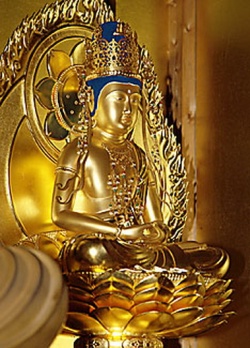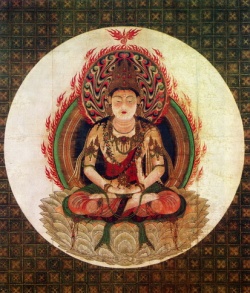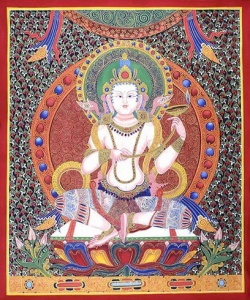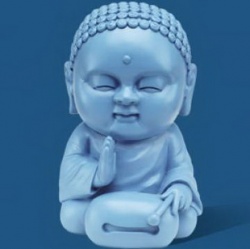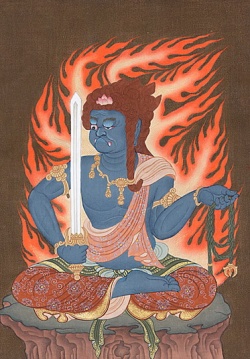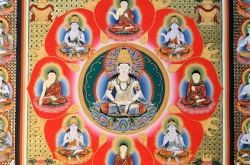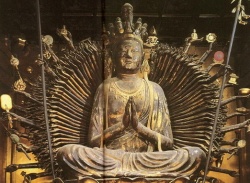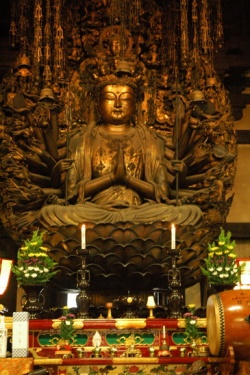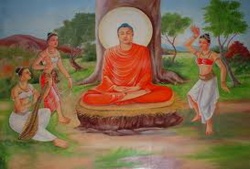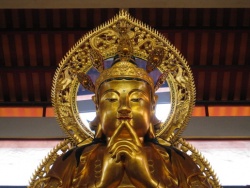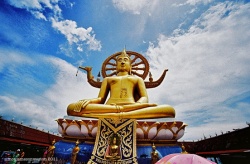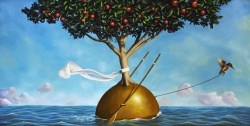Nyaya
Nyāya (Sanskrit ny-āyá, literally "recursion", used in the sense of "syllogism, inference") is the name given to one of the six orthodox or astika schools of Hindu philosophy—specifically the school of logic.
The Nyaya school of philosophical speculation is based on texts known as the Nyaya Sutras, which were written by Aksapada Gautama from around the 2nd century BCE.
- Overview
The most important contribution made by the Nyaya school to modern Hindu thought is its methodology to prove existence of God, based on the Vedas. This methodology is based on a system of logic that, subsequently, has been adopted by the majority of the other Indian schools, orthodox or not. This is comparable to how Western science and philosophy can be said to be largely based on Aristotelian logic.
However, Nyaya differs from Aristotelian logic in that it is more than logic in its own right. Its followers believed that obtaining valid knowledge was the only way to obtain release from suffering. They therefore took great pains to identify valid sources of knowledge and to distinguish these from mere false opinions. Nyaya is thus a form of epistemology in addition to logic.
According to the Nyaya school, there are exactly four sources of knowledge (pramāṇas): perception, inference, comparison, and testimony. Knowledge obtained through each of these can, of course, still be either valid or invalid. As a result, Nyaya scholars again went to great pains to identify, in each case, what it took to make knowledge valid, in the process creating a number of explanatory schemes. In this sense, Nyaya is probably the closest Indian equivalent to contemporary analytic philosophy.
- Sixteen Padārthas or Categories
The Nyaya metaphysics recognizes sixteen padarthas or categories and includes all six (or seven) categories of the Vaisheshika in the second one of them, called prameya. These sixteen categories are pramāṇa (valid means of knowledge), prameya (objects of valid knowledge), saṁśaya (doubt), prayojana (aim), dṛṣṭānta (example), siddhānta (conclusion), avayava (members of syllogism), tarka (hypothetical reasoning), nirṇaya (settlement), vāda (discussion), jalpa (wrangling), vitaṇḍā (cavilling), hetvābhāsa (fallacy), chala (quibbling), jāti (sophisticated refutation) and nigrahasthāna (point of defeat).
The Nyaya epistemology considers knowledge (jñāna) or cognition (buddhi) as apprehension (upalabdhi) or consciousness (anubhava). Knowledge may be valid or invalid.
The Naiyayikas (the Nyaya scholars) accepted four valid means (pramaṇa) of obtaining valid knowledge (prama) - perception (pratyakṣa), inference (anumāna), comparison (upamāna) and verbal testimony (śabda). Invalid knowledge includes memory (smṛti), doubt (saṁśaya), error (viparyaya) and hypothetical reasoning (tarka).
Perception
Pratyakṣa (perception) occupies the foremost position in the Nyaya epistemology. Perception is defined by Akṣapāda Gautama in his Nyaya Sutra (I,i.4) as a 'non-erroneous cognition which is produced by the intercourse of sense-organs with the objects, which is not associated with a name and well-defined'. Perception can be of two types, laukika (ordinary) and alaukika (extraordinary).
- Ordinary perception
Ordinary (Laukika or Sadharana) perception is of six types - visual-by eyes, olfactory-by nose, auditory-by ears, tactile-by skin, gustatory-by tongue and mental-by mind.
Extraordinary (Alaukika or Asadharana) perception is of three types, viz., Samanyalakshana (perceiving generality from a particular object), Jñanalakshana (when one sense organ can also perceive qualities not attributable to it, as when seeing a chili, one knows that it would be bitter or hot), and Yogaja (when certain human beings, from the power of Yoga, can perceive past, present and future and have supernatural abilities, either complete or some).
The Naiyayika maintains two modes or stages in perception. The first is called nirvikalpa (indeterminate), when one just perceives an object without being able to know its features, and the second savikalpa (determinate), when one is able to clearly know an object. All laukika and alaukika pratyakshas are savikalpa, but it is necessarily preceded by an earlier stage when it is indeterminate. Vātsāyana says that if an object is perceived with its name we have determinate perception but if it is perceived without a name, we have indeterminate perception. Jayanta Bhatta says that indeterminate perception apprehends substance, qualities and actions and universals as separate and indistinct something and also it does not have any association with name, while determinate perception aprrehends all these together with a name. There is yet another stage called Pratyabhijñā, when one is able to re-recognise something on the basis of memory.
- Inference
Anumāna (inference) is one of the most important contributions of the Nyaya. It can be of two types: inference for oneself (Svarthanumana, where one does not need any formal procedure, and at the most the last three of their 5 steps), and inference for others (Parathanumana, which requires a systematic methodology of 5 steps). Inference can also be classified into 3 types: Purvavat (inferring an unperceived effect from a perceived cause), Sheshavat (inferring an unperceived cause from a perceived effect) and Samanyatodrishta (when inference is not based on causation but on uniformity of co-existence). A detailed anaysis of error is also given, explaining when anumana could be false.
Comparison
Upamāna, which can be roughly translated as comparison is the knowledge of the relationship between a word and the object denoted by the word. It is produced by the knowledge of resemblance or similarity, given some pre-description of the new object beforehand.
Śabda or verbal testimony is defined as the statement of a trustworthy person (āptavākya), and consists in understanding its meaning. It can be of two types, Vaidika (Vedic), which are the words of the four sacred Vedas, and are described as the Word of God, having been composed by God, and Laukika, or words and writings of trustworthy human beings. Vaidika testimony is preferred as the infallible word of God, and Laukika testimony must by its nature be questioned and overruled by more trustworthy knowledge if such becomes available.
Theory of inference
The methodology of inference involves a combination of induction and deduction by moving from particular to particular via generality. It has five steps, as in the example shown:
There is fire on the hill (called Pratijñā, required to be proved)
Because there is smoke there (called Hetu, reason)
Wherever there is smoke, there is fire, e.g. in a kitchen (called Udāhārana, example of vyāpti)
The hill has smoke that is pervaded by fire (called Upanaya, reaffirmation or application)
Therefore there is fire on the hill (called Nigamana, conclusion)
In Nyāya terminology for this example, the hill would be called as paksha (minor term), the fire is called as sādhya (major term), the smoke is called as hetu, and the relationship between the smoke and the fire is called as vyapti (middle term).
Hetu further has five characteristics: (1) It must be present in the Paksha, (2) It must be present in all positive instances, (3)
It must be absent in all negative instances, (4) It must not incompatible with the minor term or Paksha and (5) All other contradictions by other means of knowledge should be absent.
The fallacies in Anumana (hetvābhasa) may occur due to the following:
Asiddha: It is the unproved hetu that results in this fallacy. (Paksadharmata)
Ashrayasiddha: If Paksha itself is unreal, then there cannot be locus of the hetu. e.g. The sky-lotus is fragrant, because it is a lotus like any other lotus.
Svarupasiddha: Hetu cannot exist in paksa at all. E.g. Sound is a quality, because it is visible.
Vyapyatvasiddha: Conditional hetu. `Wherever there is fire, there is smoke'. The presence of smoke is due to wet fuel.
Savyabhichara: This is the fallacy of irregular hetu.
Sadharana: The hetu is too wide. It is present in both sapaksa and vipaksa. `The hill has fire because it is knowable'.
Asadharana: The hetu is too narrow. It is only present in the Paksha, it is not present in the Sapaksa and in the Vipaksha. `Sound is eternal because it is audible'.
Anupasamhari: Here the hetu is non-exclusive. The hetu is all-inclusive and leaves nothing by way of sapaksha or vipaksha. e.g. 'All things are non-ternal, because they are knowable'.
Satpratipaksa: Here the hetu is contradicted by another hetu. If both have equal force, then nothing follows. 'Sound is eternal, because it is audible', and 'Sound is non-eternal, because it is produced'. Here 'audible' is counterbalanced by 'produced' and both are of equal force.
Badhita: When another proof (as by perception) definitely contradicts and disproves the middle term (hetu). 'Fire is cold because it is a substance'.
Viruddha: Instead of proving something it is proving the opposite. 'Sound is eternal because it is produced'.
The Nyaya theory of causation
A cause is defined as an unconditional and invariable antecedent of an effect and an effect as an unconditional and invariable consequent of a cause. The same cause produces the same effect; and the same effect is produced by the same cause. The cause is not present in any hidden form whatsoever in its effect.
The following conditions should be met:
The cause must be antencedent [Purvavrtti]
Invariability [Niyatapurvavrtti]
Unconditionality [Ananyathasiddha]
Nyaya recognizes five kinds of accidental antecedents [Anyathasiddha]
Mere accidental antecedent. E.g., The colour of the potter's cloth.
Remote cause is not a cause because it is not unconditional. E.g., The father of the potter.
The co-effects of a cause are not causally related.
Eternal substances, or eternal conditions are not unconditional antecedents. e.g. space.
Unnecessary things, e.g. the donkey of the potter.
Nyaya recognizes three kinds of cause:
Samavayi, material cause. E.g. Thread of a cloth.
Asamavayi, colour of the thread which gives the colour of the cloth.
Nimitta', efficient cause, e.g. the weaver of the cloth.
- Anyathakyativada of Nyaya
The Nyaya theory of error is similar to that of Kumarila's Viparita-khyati (see Mimamsa).
The Naiyayikas also believe like Kumarila that error is due to a wrong synthesis of the presented and the represented objects.
The represented object is confused with the presented one.
The word 'anyatha' means 'elsewise' and 'elsewhere' and both these meanings are brought out in error.
The presented object is perceived elsewise and the represented object exists elsewhere.
They further maintain that knowledge is not intrinsically valid but becomes so on account of extraneous conditions (paratah pramana during both validity and invalidity).
Nyaya on God and salvation
Early Naiyayikas wrote very little about Ishvara (literally, the Supreme Soul).
However, later Buddhists in India had become from agnostic to strictly atheistic. As a reaction, the later Naiyayikas entered into disputes with the Buddhists and tried to prove the existence of God on the basis of inference.
They made this question a challenge to their own existence. Udayana's Nyayakusumanjali gave the following nine arguments to prove the existence of creative God:
Kāryāt (lit. "from effect"): An effect is produced by a cause, and similarly, the universe must also have a cause. Causes (according to Naiyayikas) are of three kinds: Samavayi (in case of the universe, the atoms), Asamavayi (the association of atoms) and Nimitta (which is Ishvara). The active cause of the world must have an absolute knowledge of all the material of creation, and hence it must be God. Hence from the creation, the existence of the Creator is proved.
Āyojanāt (lit., from combination): Atoms are inactive and properties are unphysical. So it must be God who creates the world with his will by causing the atoms to join. Self-combination of inanimate and lifeless things is not possible , otherwise atoms would only combine at random, creating chaos. There is to be seen the hand of a wise organizer behind the systematic grouping of the ultimate atoms into dyads and molecules.
That final organizer is God.
Dhŗtyādéḥ(lit., from support): Just as a material thing falls off without a support, similarly, God is the supporter and bearer of this world, without which the world would not have remained integrated. This universe is hence superintended within God, which proves his existence.
Padāt (lit., from word): Every word has the capability to represent a certain object.
It is the will of God that a thing should be represented by a certain word. Similarly, no knowledge can come to us of the different things here unless there is a source of this knowledge. The origin of all knowledge should be omniscient and, consequently, omnipotent.
Such a being is not to be seen in this universe, and so it must be outside it. This being is God.
Pratyayataḥ (lit, from faith): the Hindu holy scriptures, the Vedas, are regarded as the source of eternal knowledge. Their knowledge is free from fallacies and are widely believed as a source of proof. Their authors cannot be human beings because human knowledge is limited. They cannot obtain knowledge of past, present, and future, and in depth knowledge of mind. Hence, only God can be the creator of the Vedas. Hence, his existence is proved from his being the author of the Vedas, which he revealed to various sages over a period of time.
Shrutéḥ (lit., from scriptures): The Shrutis, e.g., the Vedas extol God and talk about his existence.
"He is the lord of all subjects, omniscient, and knower of one's internal feelings; He is the cause, maintainer, and destroyer of the world", say the Shrutis. The Shrutis are regarded as a source of proofs by Naiyanikas. Hence, the existence of God is proved.
Vākyāt (lit., from precepts): World is governed by moral laws that are objective and universal.
These are again manifested by Shrutis. Hence there exists God, the promulgator of these laws.
Samkhyāviśeşāt (lit., from the specialty of numbers):According to the Nyaya, the magnitude of a dyad is produced by the number of two atoms.
The number "one" is directly perceived but other numbers are created by perceptions, which is related to the mind of the perceiver. Since at the time of creation, souls, atoms, Adŗşţa (Unseen Power), space, time and minds are all unconscious, hence it depends on divine consciousness. So God must exist.
Adŗşţāt (lit., from the unforeseen): Everybody reaps the fruits of his own actions. merits and demerits accrue from his own actions and the stock of merit and demerit is known as Adŗşţa, the Unseen Power. But since this unseen power is unintelligent, it needs the guidance from a supremely intelligent god.
- On monotheism
Not only have the Naiyayikas provided arguments to prove the existence of God, but they have also given an argument that such a God can only be one.
In the Nyayakusumanjali, this is discussed against the proposition of the Mimamsa school—that let us assume there were many gods (Devas) and sages (rishis) in the beginning, who wrote the Vedas and created the world.
Udayana says that:
[if they assume such] omniscient beings, those endowed with the various superhuman faculties of assuming infinitesimal size, and so on, and capable of creating everything, then we reply that the law of parsimony bids us assume only one such, namely Him, the adorable Lord.
There can be no confidence in a non-eternal and non omniscient being, and hence it follows that according to the system which rejects God, the tradition of the Veda is simultaneously overthrown; there is no other way open.
In other words, Udayana says that the polytheist would have to give elaborate proofs for the existence and origin of his several celestial spirits, none of which would be logical. So it is much more logical to assume only one, eternal and omniscient God.
On salvation
The Naiyayikas believe that the bondage of the world is due to false knowledge, which can be removed by constantly thinking of its opposite (pratipakshabhavana), namely, the true knowledge.
So the opening aphorism of the Nyāya Sūtra states that only the true knowledge lead to niḥśreyasa (salvation).
But the Nyaya school also maintains that the God's grace is essential for obtaining true knowledge.
Jayanta, in his Nyayamanjari describes salvation as a passive stage of self in its natural purity, unassociated with pleasure, pain, knowledge and willingness.
- Literature of Nyaya
The earliest text of the Nyāya School is the Nyāya Sūtra of Akṣapāda Gautama.
The text is divided into five books, each having two sections. Vātsāyana's Nyāya Bhāṣya is a classic commentary on the Nyāya Sūtra.
Udyotakara's Nyāya Vārttika (6th century CE) is written to defend Vātsāyana against the attacks made by Dignāga.
Vācaspati Miśra's Nyāyavārttikatātparyaṭīkā (9th century CE) is the next major exposition of this school.
Two other texts, Nyāyaṣūcinibandha and Nyāyasūtraddhāra are also attributed to him. Udayana's (984 CE) Nyāyatātparyapariśuddhi is an important commentary on Vācaspati's treatise.
His Nyāyakusumāñjali is the first systematic account of theistic Nyāya. His other works include Ātmatattvaviveka, Kiraṇāvali and Nyāyapariśiṣṭa. Jayanta Bhatta's Nyāyamañjari (10th century CE) is basically an independent work. Bhāsavarajña's Nyāyasāra (10th century CE) is a survey of Nyāya philosophy.
The later works on Nyāya accepted the Vaiśeṣika categories and Varadarāja's Tārkikarakṣā (12th century CE) is a notable treatise of this syncretist school.
Keśava Miśra's Tārkabhaṣā (13th century CE) is another important work of this school.
Gangeśa Upādhyāya's Tattvacintāmaṇi (12th century CE) is the first major treatise of the new school of Navya Nyāya.
His son, Vardhamāna Upādhyāya's Nyāyanibandhaprakāśa (1225 CE), though a commentary on Udayana's Nyāyatātparyapariśuddhi, incorporated his father's views.
Jayadeva wrote a commentary on Tattvacintāmaṇi known as Āloka (13th century CE).
Vāsudeva Sārvabhauma's Tattvacintāmaṇivyākhyā (16th century CE) is first great work of Navadvipa school of Navya Nyāya.
Raghunātha Śiromaṇi's Tattvacintāmaṇidīdhiti and Padārthakhaṇḍana are the next important works of this school.
Viśvanatha's Nyāyasūtravṛtti (17th century CE) is also a notable work.
The Commentaries on Tattvacintāmaṇidīdhiti by Jagadish Tarkalankar (17th century CE) and Gadadhar Bhattacharya (17th century CE) are the last two notable works of this school.
Annaṁbhatta (17th century CE) tried to develop a consistent system by combining the ancient and the new schools, Prācina nyāya and Navya nyāya and Vaiśeṣika to develop the nyāya-vaiśeṣika school.
His Tarkasaṁgraha and Dīpikā are the popular manuals of this school.
